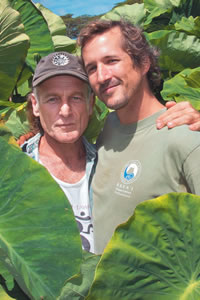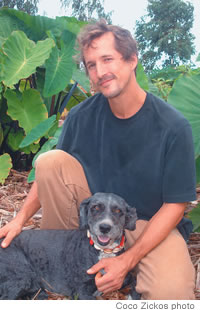The Power of Taro

Paul Massey of Regenerations Botanical Garden believes taro, a basic in the traditional native Hawaiian diet, is just as important in the future. It's one of the varieties available at Saturday's plant and seed exchanges. Here he's with uhi, white yam
How does a guy from California end up on Kaua’i as perhaps the biggest proponent of taro on the island? “Bit by the taro bug in a big way,” says Paul Massey of Regenerations Botanical Garden, explaining his passion for kalo (taro) as he proudly shows off the many different varieties he’s growing in a Kilauea community garden.
“If any plant the Polynesians brought with them was the most important to them, taro is the one,” says the sustainable gardening enthusiast, who is focused on perpetuating plant diversity across the island.
“I want to continue to amass an essential collection of plants of different species and varieties to ensure our comfortable and healthy lifestyle on Kaua’i,” says Massey who, along with Regenerations Botanical Garden’s co-founder Jill Richardson, runs a seed bank in Kapahi. “It’s about empowering people to make smart choices about which plants to grow and how to grow them, no matter where you are or what your skill level is.”
Taro is one of nearly 700 native plant species in Hawaii, and it’s a prime example of creating a more self-sufficient lifestyle on-island, according to Massey. Native species are those that existed prior to human settlement, including endemic (evolved into a unique species) and indigenous (found in other parts of the world), as well as those brought by native inhabitants.

Paul Massey and Jill Richardson, his partner and organizer of the seed and plant exchange
Kalo is one of the most digestible starches on the planet, Massey explains, and can be used as food security.
“We can grow food sustainably in our landscapes,” he says. “Taro is a beautiful ornamental plant, so we could be growing it, and if the moment comes and times are lean, we actually have food in our landscape.”
And while the majority of native plants – nearly 500 – are not considered to be threatened species, it creates “an opportunity for us to grow more and more of them and to find those niches and become reacquainted with their uses,” he says. “Ultimately, people grow plants if they’re useful to them. That’s where we have our sweet spot. Finding out and discovering with our community what plants people are excited about growing, and also working to influence people to grow plants that need to be protected and conserved.”
Massey’s passion for plants began in New England, where he says he fell in love with nature during his childhood. He didn’t have his first garden, however, until he lived in Boulder, Colo.
“It wasn’t hugely successful, but it definitely sparked the interest,” he says.
By 1998, Massey moved to Kaua’i, as he immediately felt a connection on a prior visit. Since working in desktop publishing in Colorado was no longer quenching his return-to-nature thirst, he packed his bags and relocated to the island, where outdoor adventures and a year-round growing climate awaited.

Paul Massey and Mayor Bernard Carvalho harvest taro
Having many direct experiences with native Hawaiian plants in the wild, it wasn’t long before Massey become closely acquainted with the many different species and developed a desire to propagate them.
“Plants are the greatest teachers,” he says. “They are resilient and have a persistent quality to them. They’re tough; they’re strong. It seemed that with a small effort on my part, I could effect a great change.”
Since then, however, Massey, who formed Regenerations Botanical Garden in 2006, says he has learned it is an art form to grow sustainably, utilizing all local resources.
“Sustainable growing is ensuring that a proper management of the vital resources of the planet are cared for in such a way that the inputs and outputs of our growing endeavor focus on nourishing the system, and ensuring we’re not depleting the resources for future generations,” says Massey.

There was plenty of talking and swapping at last year’s seed and plant exchange
Organic matter used for sustainable growing includes chipped mulches, old plants that can be churned back into the system and island-generated nutrients and minerals.
Massey also is an instructor at Kaua’i Community College, where he’s the coordinator of the gardening and farming training program. Glenn Hontz, coordinator and director of the Food Industry Program at KCC, calls Massey “one of the most inspiring people I have ever worked with.”
Adds Hontz: “Paul is a model of the kind of leadership we need today. He is bright, enthusiastic and convincing. He doesn’t criticize; he corrects. He doesn’t compete; he cooperates. He builds friendships that become dedicated alliances that seek to bring forth sustainable improvements in the way that things need to get done. And he sees today’s problems as the seeds for tomorrow’s enlightenment.”
A self-proclaimed optimist, Massey says he surrounds himself with people who are seeking the solution.

Kamran Taleb and Paul Massey are co-hosts of ‘Back to the Garden’ on KKCR
Even though Kaua’i currently imports about 85 percent of its food, Massey says “more and more of what people are putting on their plates is coming from the island.”
Gardens are sprouting up across Kaua’i, and as his KKCR Back to the Garden radio show co-host Kamran Taleb says, “it’s the golden age of gardening.”
“So much knowledge is at our fingertips, and so many people on Kaua’i and in Hawaii are experimenting with alternative technologies in nourishing soil and increasing nutrients,” he says. “Compared to any time in history, we are equipped with the skills and resources we need to become more self-sufficient.”
Those who hold the knowledge – the elders, or kupuna – are “ready to share it with people who are ready to learn,” says Massey, who completed a horticulture internship program at the National Tropical Botanical Garden and holds two plant-related diplomas from the Royal Botanic Garden in England.

Massey with his dog ‘Ela
“It’s been one of the biggest blessings,” he says. “With my sincere wish, I’ve been able to learn.”
As Regenerations Botanical Garden, a “community-based plant stewardship organization,” continues to spread its seeds and insight across the island, Massey says it also will harbor the idea of having a botanical garden across the whole landscape.
“It’s really about a community gardening project that knows no boundaries across the landscape,” he says. “Wherever people are growing plants that they’ve received from this network in their homes, it has a foothold there.”
Empowering gardeners and interesting others is what the nonprofit is all about. Massey says it’s common sense, a simple way to make a huge impact.
Regenerations Botanical Garden will host its sixth biannual Kaua’i Community Seed and Plant Exchange from noon to 6 p.m. Nov. 13 at Hanapepe United Church of Christ.
The free event is “designed to facilitate local growers in the ongoing stewardship of valuable plant diversity that’s essential to our high quality of life by producing, saving, and sharing seeds and other plant material with island neighbors,” says Richardson, the project’s chief coordinator. “All seeds and plants at the exchange are given freely or traded.”
Call 652-4118 or visit ribg.org for more information.
You must be logged in to post a comment.




There are no comments
Add yours